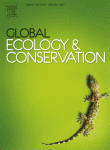View Item
- xmlui.general.dspace_homeCentros Regionales y EEAsCentro Regional La Pampa - San LuisEEA AnguilArtículos científicosxmlui.ArtifactBrowser.ItemViewer.trail
- DSpace Home
- Centros Regionales y EEAs
- Centro Regional La Pampa - San Luis
- EEA Anguil
- Artículos científicos
- View Item
High quality residues from cover crops favor changes in microbial community and enhance C and N sequestration
Abstract
The objective of the study was to evaluate the effect of a change in management on the soil microbial community and C sequestration. We conducted a 3-year field study in La Pampa (Argentina) with rotation of sorghum (Sorghum bicolor) in zero tillage alternating with rye (Secale cereale) and vetch (Vicia villosa ssp. dasycarpa). Soil was sampled once a year at two depths. Soil organic matter fractions, dissolved organic matter, microbial biomass (MBC) and
[ver mas...]
The objective of the study was to evaluate the effect of a change in management on the soil microbial community and C sequestration. We conducted a 3-year field study in La Pampa (Argentina) with rotation of sorghum (Sorghum bicolor) in zero tillage alternating with rye (Secale cereale) and vetch (Vicia villosa ssp. dasycarpa). Soil was sampled once a year at two depths. Soil organic matter fractions, dissolved organic matter, microbial biomass (MBC) and community composition (DNA extraction, qPCR, and phospholipid FAME profiles) were determined. Litter, aerial- and root biomass were collected and all material was analyzed for C and N. Results showed a rapid response of microbial biomass to a bacterial dominance independent of residue quality. Vetch had the highest diversity index, while the fertilized treatment had the lowest one. Vetch–sorghum rotation with high N mineralization rates and diverse microbial community sequestered more C and N in stable soil organic matter fractions than no-till sorghum alone or with rye, which had lower N turnover rates. These results reaffirm the importance of enhanced soil biodiversity for maintaining soil ecosystem functioning and services. The supply of high amounts of N-rich residues as provided by grass–legume cover crops could fulfill this objective.
[Cerrar]

Author
Fuente
Global ecology and conservation 6 : 242-256. (April 2016)
Date
2016
ISSN
2351-9894 (Online)
Formato
pdf
Tipo de documento
article
Palabras Claves
Derechos de acceso
Abierto
 Excepto donde se diga explicitamente, este item se publica bajo la siguiente descripción: Creative Commons Attribution-NonCommercial-ShareAlike 2.5 Unported (CC BY-NC-SA 2.5)
Excepto donde se diga explicitamente, este item se publica bajo la siguiente descripción: Creative Commons Attribution-NonCommercial-ShareAlike 2.5 Unported (CC BY-NC-SA 2.5)


